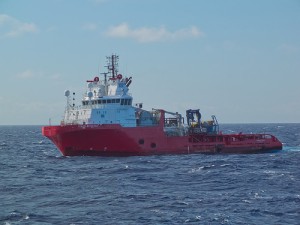
Remotely operated vehicles (ROVs) are safe and widely used type of underwater controlled vehicle. They are connected to the topside via an umbilical link that houses communications cables, an energy source and information transfer. Using a series of propellers, ROVs are unoccupied, highly manoeuvrable underwater robots operated by a person on the surface.
Usually, ROVs are equipped with at least one video camera and lights. Additional equipment may include one or more sonars, stills camera, manipulator or cutting arm, and a wide range of sampling options. Generally, they are free flying, however some are bottom-founded operating on tracks or wheels. The sizes can vary from small vehicles fitted with one TV camera, (usually used for simple observation), to complex systems incorporating dexterous manipulators, video cameras, mechanical tools and other equipment.
ROVs provide virtually unlimited bottom time with high bandwidth for high-resolution video and data transmission. The ROV system has a precise navigational control and tracking which makes it a perfect device for conducting underwater research and surveys.
ROVs were first used by the military in the 1960s advancing the technology to an operational state in its quest to develop robots to recover underwater ordnance lost during at-sea tests. As the oil and gas industry moves to a more subsea environment, ROVs will become an even more important tool in drilling, development and repair offshore by the year 1980s. Since then, designs have evolved and capabilities increased. They can operate at greater depths, carry much higher-resolution cameras, more sensitive sonar, and more capable manipulator arms. Some ROVs are being built to work on specific subsea developments, with manipulators and tools designed for work on equipment in a precise field.